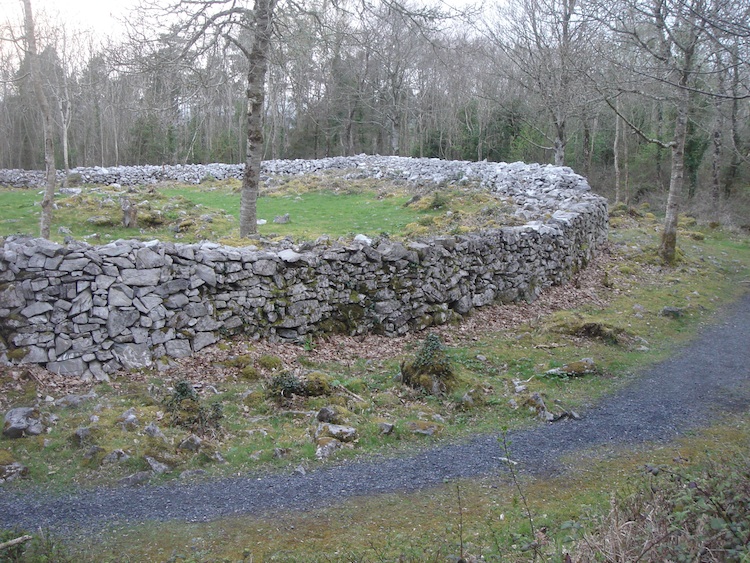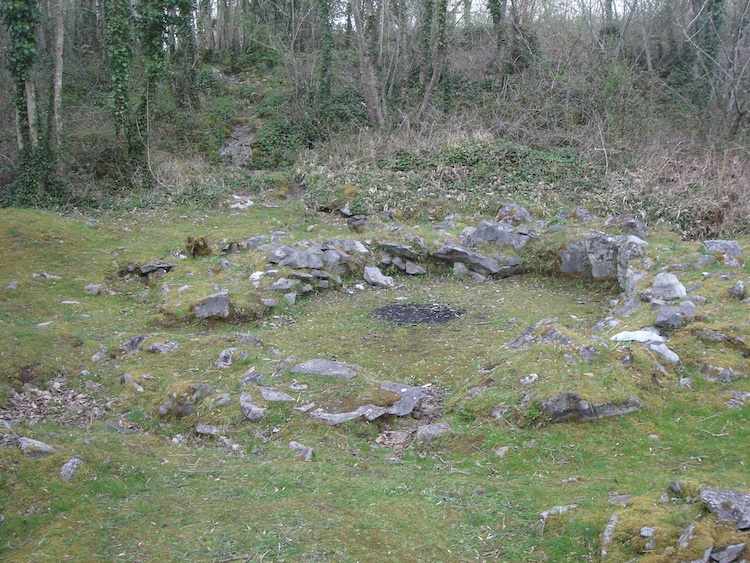Mooghaun Cashel on:
[Wikipedia]
[Google]
[Amazon]

 Mooghaun () is a late
Mooghaun () is a late
University of Notre Dame
{{Tourism in County Clare Forts in Ireland


Bronze Age
The Bronze Age is a historic period, lasting approximately from 3300 BC to 1200 BC, characterized by the use of bronze, the presence of writing in some areas, and other early features of urban civilization. The Bronze Age is the second pri ...
hill fort
A hillfort is a type of earthwork used as a fortified refuge or defended settlement, located to exploit a rise in elevation for defensive advantage. They are typically European and of the Bronze Age or Iron Age. Some were used in the post-Roma ...
located in County Clare
County Clare ( ga, Contae an Chláir) is a county in Ireland, in the Southern Region and the province of Munster, bordered on the west by the Atlantic Ocean. Clare County Council is the local authority. The county had a population of 118,817 ...
, Ireland. It is a well preserved, recently excavated site, occupying an entire hill with wide views of the surrounding lands. Believed to be the largest hill fort in Ireland, it is one of the region's main tourist attractions.
Location and physical description
Mooghaun is situated in the parish of Mooghaun South, north north-east ofNewmarket on Fergus
Newmarket-on-Fergus, historically known as Corracatlin (), is a town in County Clare, Ireland. It is 13 kilometres from Ennis, 8 kilometres from Shannon Airport, and 24 kilometres from Limerick.
History
The English rendering of the name 'Newm ...
, on the grounds of Dromoland Castle
Dromoland Castle ( ga, Drom Ólainn) is a castle, located near Newmarket-on-Fergus in County Clare, Ireland. It is operated as a five-star luxury hotel with a golf course, with its restaurant, the "Earl of Thomond", being awarded a Michel ...
.
It has three concentric limestone
Limestone ( calcium carbonate ) is a type of carbonate sedimentary rock which is the main source of the material lime. It is composed mostly of the minerals calcite and aragonite, which are different crystal forms of . Limestone forms whe ...
rampart
Rampart may refer to:
* Rampart (fortification), a defensive wall or bank around a castle, fort or settlement
Rampart may also refer to:
* "O'er the Ramparts We Watched" is a key line from "The Star-Spangled Banner", the national anthem of the ...
s of defence, all built at the same time. The outermost wall encloses , the middle one , and the innermost . It occupies the summit of a hill with views, nowadays largely obscured by trees, of the chiefdom it controlled. The grounds also hold a number of cashels which are of later date.
History
The hill fort was built at the beginning of the late Bronze Age, around 950 BC. At the time, Mooghaun was the largest and most important site in the area. It holds three cashels, which were built after 500 AD. For the construction of the defending walls, stones of the original ramparts were used. Beside the cashels, outlines of round houses were found. Perhaps 10 or 12 families lived within the bounds of the hill fort. These families tended to farm land within the enclosure and also kept livestock there. They lived mainly in the middle enclosure. The people who directed its construction were the leaders over a chiefdom in south-east Clare that covered an area of about . The chiefdom is considered to have been bordered by the Shannon estuary to the south, and mountain ranges to the north, east and west. Their territory was divided into smaller territories of about , which were controlled by important families. These lived in smaller defended hilltop sites and lake settlements. The less important families lived in settlements that were enclosed by low stone banks. These often occurred in clusters, each farming an area of about 154 to 315 hectares (381 to 778 acres). The site of the cashels was used in the late eighteenth or early nineteenth century by the inhabitants of the nearby Dromoland estate as a viewing point or even a picnic spot. To facilitate this use, much of the interior was destroyed and repairs were made to the walls.Mooghaun North Hoard
A very large hoard of Late Bronze Age gold jewellery was discovered in the neighbouring parish of Mooghaun North in 1854, during construction of a railway fromLimerick
Limerick ( ; ga, Luimneach ) is a western city in Ireland situated within County Limerick. It is in the province of Munster and is located in the Mid-West which comprises part of the Southern Region. With a population of 94,192 at the 2016 ...
to Ennis
Ennis () is the county town of County Clare, in the mid-west of Ireland. The town lies on the River Fergus, north of where the river widens and enters the Shannon Estuary. Ennis is the largest town in County Clare, with a population of 25,27 ...
. It appears to have numbered several hundred objects, but most were sold to jewellers and melted down, though many replicas were made. Only 29 originals survive, divided between the National Museum of Ireland
The National Museum of Ireland ( ga, Ard-Mhúsaem na hÉireann) is Ireland's leading museum institution, with a strong emphasis on national and some international archaeology, Irish history, Irish art, culture, and natural history. It has thre ...
and the British Museum
The British Museum is a public museum dedicated to human history, art and culture located in the Bloomsbury area of London. Its permanent collection of eight million works is among the largest and most comprehensive in existence. It docum ...
. Most objects were plain gold hoops in various sizes, from bracelets (the majority) to torc
A torc, also spelled torq or torque, is a large rigid or stiff neck ring in metal, made either as a single piece or from strands twisted together. The great majority are open at the front, although some had hook and ring closures and a few had ...
s, with some wide gold collars also. There were some ingots. The find was near Mooghaun Lough and was probably a ritual deposit, which must have represented a huge amount of wealth at the time.Wallace, 99
Notes
References
* *Wallace, Patrick F., O'Floinn, Raghnall eds. ''Treasures of the National Museum of Ireland: Irish Antiquities'', 2002, Gill & Macmillan, Dublin,External links
University of Notre Dame
{{Tourism in County Clare Forts in Ireland